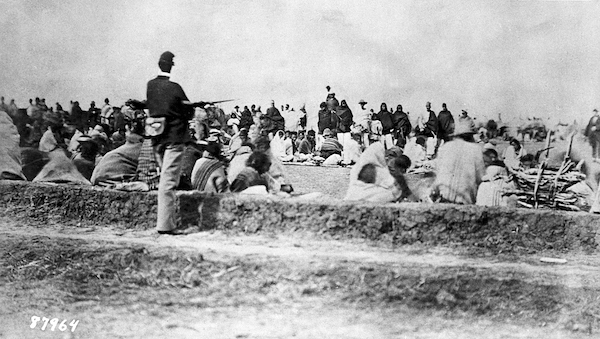Bosque Redondo Memorial at Fort Sumner Historic Site
History

The center of a million-acre reservation known as the Bosque Redondo, this site represents one of the most tragic periods in American history.
As Spaniards, Mexicans and Americans settled in the territory of New Mexico, they were subject to raids from the Diné (Navajo) and Ndé (Mescalero Apache) people who fought to maintain their traditional homelands and to obtain valuable resources from the settlers. In efforts to control the raiding the Spanish, the Mexicans and then the Americans, fought the Indians. Treaties were written and broken, nothing much changed. Raiding continued until the early 1860s when a significant military force became available.
In 1863, when the US Army had defeated the invading Confederates in New Mexico, there was a large enough military force available to deal with the “Indian problem”. It was decided that these "problematic" indigenous people would be brought to a spot far away from the populated areas of the Territory. There they could be taught to farm and learn the ways of the white man as means of assimilation and cultural genocide.
The Ndé were the first to be subdued and brought to Bosque Redondo early in 1863. They were promised that if the moved to Bosque Redondo and behaved, they would be cared for.
Known by the Diné as the "Long Walk," over 50 different groups were forced to walk a distance of more than 350 miles to the reservation in east central New Mexico. It was an arduous journey that saw them travel 12-15 miles a day, often in chilling cold or stifling heat. Hundreds of Diné died as a result of these conditions. As well, those who could not keep up with this pace (tribal elders, the sick, pregnant women) were shot. The Diné continued to arrive at Bosque Redondo for a period of over two years.
At its peak in the winter of 1864, more than 8,500 Diné and nearly 500 Ndé people were held at the Bosque Redondo Indian Reservation.
Most of the Ndé became so disenchanted with life as farmers and the meager rations that they left in the night during November of 1865 to go home. A small group who could not keep pace with the hasty departure, stayed behind to keep the campfires going so the army would not realize that the tribe had left. The Mescaleros scattered to create many trails and frustrate their pursuers. Some headed to Mexico, some joined the Warm Springs and Lipan Apaches, and some joined Comanche bands. Small groups of Ndé wandered for years until negotiations began for the Mescalero Apache Reservation in the early 1870s. In 1871 A. J. Curtis, acting Agent for the Ndé, based out of Fort Stanton, proposed a reservation be established for the tribe within their ancestral mountains, the White and Sacrementos. On May 29, 1873, by executive order of President Ulysses S. Grant, the Mescalero Apache Reservation was authorized. Although this provided a promise of refuge for the Ndé, it came at a great cost to their freedom.
For the Diné, another three years of crop failures, suffering and death preceded the arrival of General Sherman and his Peace Commission to investigate reports of government waste and mistreatment of the Diné. He found the reports to be true and began to affect solutions; he first offered the Diné leaders an expense paid trip to Oklahoma. They turned him down and instead asked to go home. Talks began between the Diné headmen and the Peace Commission.
Negotiations with the Diné resulted in the Treaty of 1868 signed on June 1st, 1868. The Diné were allowed to return to their traditional homelands in the four corners region of the southwest.
Today the Navajo Nation is the largest Native American group in the United States with a population of nearly 400,000.
For more information on this history, click HERE to access the timeline.


